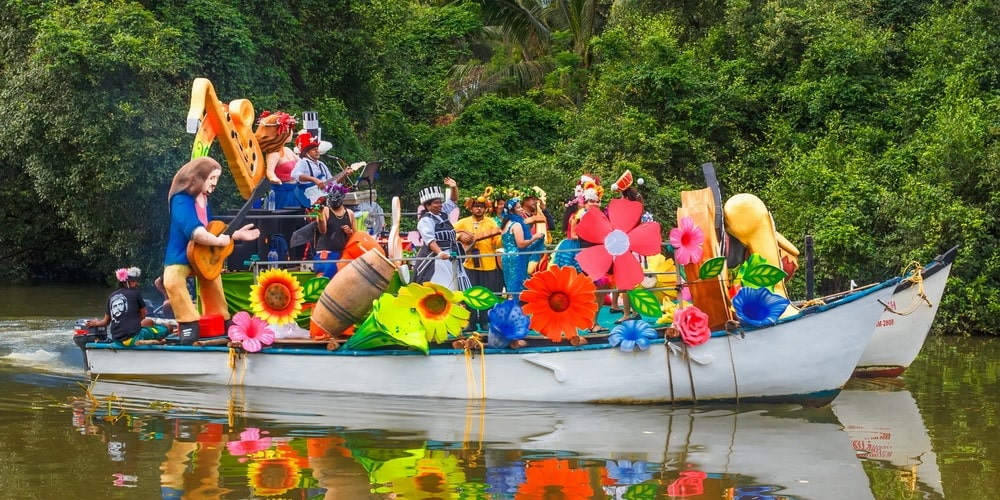Sao Joao is celebrated with great joy and fervour. The young and old traditionally jump into wells and ponds sporting a crown of flowers on their head and scream ‘Viva Sao Joao'

Goa is not only known to the world as a beach destination but also as a land of festivities. The Catholic Church commemorates the feast of St John the Baptist on June 24. After the Portuguese established Estado de Goa, Goans started celebrating important festivals of the Catholic Church. According to Christian scriptures, when Mary informed Elizabeth that she was expecting Jesus, St John the Baptist jumped for delight inside his mother Elizabeth's womb (Lk 1:41).
In the New Testament, St John the Baptist plays a significant role. Jesus Christ was baptised in the Jordan River by St John. Jesus begins his task of preaching to the people after his baptism. One of the first martyrs in the New Testament is St John the Baptist.The Celebration
The festival of Sao Joao brings families and friends together during the seasonal showers. This is one of the festivals, after the village patron feast, which is celebrated with its traditional fanfare. Children and youth go around selecting flowers to craft their own kopel - a headband or crown festooned with fresh flowers and creepers.
Sao Joao is celebrated with joy and great fervour in several Goan villages such as Candolim, Calangute, Siolim, Anjuna, Chapora, and Assagao. Everyone eagerly waits for the main highlight of the day which is the “Sangodd” or boat parade. The boats would look colourful as they were uniquely decorated with flowers. Some canoes are decorated with themes that portray social issues such as the football world cup, nature/environment preservation, pollution, etc. People on the boat sing mandos/dulpods to the tune of violin, ghumott, trumpet, and other instruments.
The most striking feature of Sao Joao is the Siolim Traditional Boat Festival which is being held for more than a quarter of a century. The festival attracts revellers from different parts of Goa. The festivities begin with the boat parade comprising seven to eight boats making their way through the river to the creek opposite the St Anthony Church. The big cross is first crowned with a colourful ‘kopel’ and then the participants get on stage and sing songs. Boats from Siolim and the neighbouring villages of Vagator, Chapora, Anjuna, Badem and Assagao participate. The best-decorated boats and best kopel are awarded prizes. The entertainment continues for the evening with songs sung by Tiatrists and many local artists. Folk songs and dances are also performed on the stage set on the bank of the creek. The festivities conclude with a marvellous display of fireworks.
In South Goa, particularly Benaulim whose patron saint is John the Baptist, the villagers have a revelling time by visiting each and every household and jumping into the well. In most of the villages, groups of youngsters move around with kopel on their heads and a coconut leaf stalk in hand that they beat to the ground to chants of “Sao Joao.” Bhutea Bhat, a small hamlet in the vicinity of the Port City of Vasco, comes fully alive on Sao Joao day. Small houses line up the narrow roads and internal streets in this small locality inhabited by Catholics, Hindus and Muslims alike. The celebration begins with a prayer service at St Sebastian Chapel in Bhutea Bhat. Later, the revellers march towards the other wells in the village by bursting crackers and dancing to the tunes of the song Sao Joao, Sao Joao.
Different delicacies like Sannas (rice cakes), Donne orHolle are prepared on this occasion. Holle made with finely ground rice flour with a filling of scraped coconut and jaggery mixed together. Donne is made with a similar holle batter but stuffed in a cone-shaped jackfruit leaf and steamed. Sannas is made with rice soaked overnight and ground the next day with toddy and a sprinkle of salt. The ready batter is then placed in a small round container called kompro and steamed. Traditional sweets like godshem, boiled jackfruit seeds and sweet moogache vonn are also served to the revellers.
It is an occasion to welcome the newly-married daughters of the village to their maiden home with their husbands and take part in the revelry. The feast is locally known as Zanvoianchem fest. The family places decorated kopels on their heads and welcome them. The family and neighbours then pray for their marriage to prosper and blossom. The newly married couples and those couples with a newborn are offered with plate/tali containing fruits such as monseradmango, pineapples, bananas, jackfruits, and a bottle of feni. It is also an opportunity for the villagers to interact with the Zanvoims (sons-in-law).
The celebration is incomplete without singing the song of C Alvares:
Sao Joao, Sao Joao gunvta mure, vatt amkam dissonam | Aicho dis urbecho konn konnak hansonam | Choll-re pie-re tum illo ghe-re faleam kaim mevonam | Oslim festam vorsak kiteak don pauti yenam.
Zanvoim ami festak aileanv mhunn, vaddeant bobau poddla | Mojea sasupain tin kouxe soro addle | Tin kuddvanchim sandnam keleant ani dukor marla | Sezarchea konsu manan ponos daddla. Sao Joao, Sao Joao…